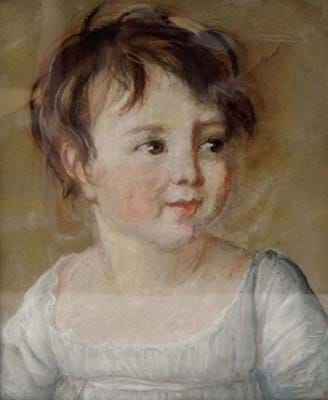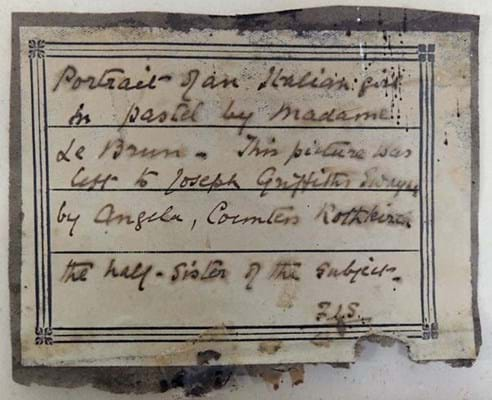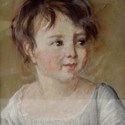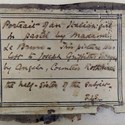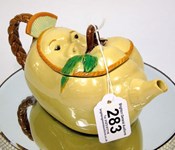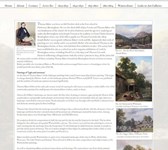A simple, unsigned pastel drawing with a tear in the corner showing a smiling young girl turned heads when it came up for sale at Bridgwater saleroom Tamlyns (18% buyer’s premium).
It was guided at just £100-150, but ending up making £2300, more than 10 times the top estimate.
The result is a good example of the significance of labels remaining on the back of an artwork, which initially led to a catalogue note by the auctioneers: ‘In the manner of Elisabeth Vigée Le Brun.’
The tantalising link to the French artist Elisabeth Vigée Le Brun (1755-1842), who was one of the few female portraitists to reach the highest level – painting royalty such as Queen Marie-Antoinette – was the key to the interest at this August 30 sale.
The 13 x 10½in (32.5 x 27cm)picture was bought by a commission bidder who lives in the UK, and, from what Tamlyns can glean, is a private collector who is “extremely happy with the purchase”. The underbidder was a trade buyer in the room, but competition also came via a phone bidder from France.
Tamlyns auctioneer Claire Rawle said: “It was a lovely portrait but did have quite a long tear in the paper which just extended into the hairline of the child, so it will need some careful restoration.
“The great thing was that when I took all the horrible brown paper off the back, two handwritten notes were concealed inside so the details were still clear.”
One label read Portrait of Italian girl in pastel by Madame Le Brun. This picture was left to Joseph Griffiths Swayne by Angela, Countess Rothleiron the half-sister of the subject with initials looking like JGS. The other included the words Portrait by Madame Le Brun – taken about 1803 – J Swayne esq.
The provenance given in the catalogue was that the pastel was consigned from the family by descent. Rawle added: “It is always great to have something that has been in the family for generations – also something that the family did not ‘tidy up’ so the notes were still with the picture.”
A Joseph Griffiths Swayne was an English obstetric physician (1819-1903) now known for investigations on cholera, but the family who consigned the pastel were unable to confirm if this was the same person.
Detective work
One expert intrigued by the pastel was art historian Neil Jeffares, who runs the pastellists.com website and has written the Dictionary of pastellists before 1800 (published in the UK in 2006 but also available online).
In fact, he was so quick off the mark after the Tamlyns auction that an extensive blog was available straightaway after what he terms “a little detective work”.
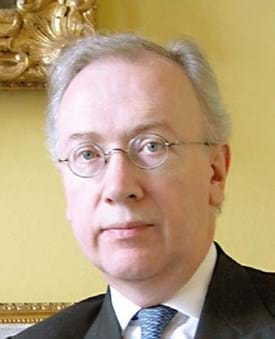
Art historian Neil Jeffares.
Jeffares has narrowed the pastel down to Vigée Le Brun’s London trip from 1803-05 (the artist, who fled the French Revolution, was not allowed back to Paris at this time). As he writes, “the circles she moved in are well documented”, and in particular “included a group of internationally renowned musicians and performance artists”.
He believes the girl depicted in the pastel drawing is Caroline Nelson Bianchi (1802-07), daughter of Italian composer Francesco Bianchi and his wife, the singer Jane Bianchi. Jeffares notes that Caroline’s middle name reflects how closely the couple “moved in the same circles as Le Brun”.
Jeffares told ATG the pastel first came to his attention on the Tamlyns website and he deduced the story by taking a closer look at the exact wording of the labels.
He stressed that he has not seen the pastel directly, and was relying on low-resolution images sent to him. But on this basis “there seems to me no reason to doubt that this is an autograph work by Mme Vigée Le Brun, and as I set out in my article, the chronology and narrative supports this”.
Jeffares added: “Vigée Le Brun was a prolific pastellist, particularly when she travelled (carrying a box of pastels was much easier than the paraphernalia required for oil painting, and she was one of the first to use pastels for landscape during her travels throughout Europe).
“The rapid technique here is identical to a good many other Vigée Le Brun pastels from this period: you can find dozens of examples in the online dictionary article [on pastellists.com]. It is likely that Vigée Le Brun made this sketch for friends rather than as a formal commission.”
Jeffares also provides an in-depth Vigée Le Brun biography in his online dictionary.
Elisabeth Vigée Le Brun factfile
■ Born as Elisabeth-Louise Vigée in Paris, 1755. Her father Louis painted in pastels and taught her until his death in 1767.
■ As a woman, she could not take art classes, and after marrying an art dealer (Jean-Baptiste-Pierre Le Brun), she should also have been blocked from entering the Academie Royale. But the queen, Marie-Antoinette, intervened to admit her in 1783, becoming one of only four women members.
■ She became famous for portraits, including royalty and the nobility. Forced to flee Paris to Italy in 1789, Le Brun then worked in Florence, Naples, Vienna, St Petersburg and Berlin before going back to France, taking sittings from, among others, members of the royal families of Naples, Russia, and Prussia painting royalty and society.
■ A 2015-16 exhibition, Vigée Le Brun: Woman Artist in Revolutionary France, was held in Paris, New York and Ottawa (the first retrospective and only the second exhibition devoted to Vigée Le Brun in modern times). Exhibition notes describe her as ‘one of the finest 18th century French painters and among the most important of all women artists’.
■ An autodidact with exceptional skills as a portraitist, she achieved success in France and Europe during one of the most eventful, turbulent periods in European history.


